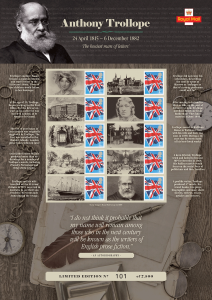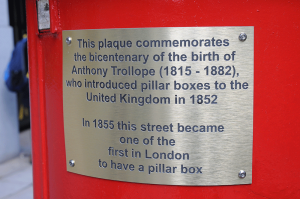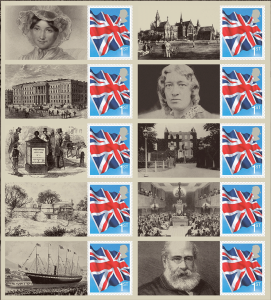[press release]
ROYAL MAIL COMMEMORATES THE BICENTENARY OF ANTHONY TROLLOPE’S BIRTH, THE “GRANDFATHER” OF THE POSTBOX
 Royal Mail is commemorating the bicentenary of Anthony Trollope’s birth in 1815 with a limited edition Commemorative Sheet of stamps
Royal Mail is commemorating the bicentenary of Anthony Trollope’s birth in 1815 with a limited edition Commemorative Sheet of stamps
The Commemorative Sheet will go on sale on 24 April 2015 – 200 years since Trollope was born
Famous as a novelist, Trollope is also known for introducing freestanding postboxes, or pillar boxes, to the UK from 1852 during his time working at the Post Office. In recognition of this, Royal Mail has created an online “family tree” of postboxes through the ages, with help from the Letter Box Study Group
 Postboxes were first erected in London on five streets in 1855. Royal Mail will attach a plaque to a postbox in each of these streets in the capital as part of its Trollope bicentenary celebrations. The streets are: Fleet Street, The Strand, Piccadilly, Pall Mall and Rutland Gate in Kensington.
Postboxes were first erected in London on five streets in 1855. Royal Mail will attach a plaque to a postbox in each of these streets in the capital as part of its Trollope bicentenary celebrations. The streets are: Fleet Street, The Strand, Piccadilly, Pall Mall and Rutland Gate in Kensington.
Royal Mail has created a special postmark to mark Trollope’s bicentenary. This will appear on stamped mail across the UK from 24 April for one week. Royal Mail only issues special postmarks for major events in the UK or to mark special historic dates.
Royal Mail is also supporting the British Postal Museum & Archive’s “Pop it in the Post” exhibition examining how the postal service changed in the Victorian era, driven by the appearance of postboxes in streets across the UK. Further details about the BPMA’s exhibition can be found here.
Pillar boxes were instrumental in changing the postal service during the latter half of the 19th century as they were installed across the UK. Royal Mail is supporting The British Postal Museum & Archive’s “Pop it in the Post” exhibition that examines those changes, The introduction of stamps and the expansion of the network of postboxes around the country made it easier and cheaper for people to send letters across the country.
The family-friendly exhibition opens at the Islington Museum in London on 28 March and runs to the 2 May 2015. It moves to Mansfield Museum in the autumn and will run from 3 October to 21 November 2015. It will then open at the Havering Museum early in 2016. Visitors will be able to see some of the original postboxes, as well as some of the equipment used by Trollope during his time with the Post Office.
 Sue Whalley, Royal Mail’s Chief Operating Officer, said: “We are delighted to contribute to this year’s bicentenary celebrations of the birth of Anthony Trollope. He is well-known as a former Post Office employee and we have him to thank for introducing pillar boxes to the UK. Whether in walls, on poles or freestanding, the network of postboxes has grown from Trollope’s time to reach around over 115,000 boxes which are now an iconic feature of communities across the UK.”
Sue Whalley, Royal Mail’s Chief Operating Officer, said: “We are delighted to contribute to this year’s bicentenary celebrations of the birth of Anthony Trollope. He is well-known as a former Post Office employee and we have him to thank for introducing pillar boxes to the UK. Whether in walls, on poles or freestanding, the network of postboxes has grown from Trollope’s time to reach around over 115,000 boxes which are now an iconic feature of communities across the UK.”
Michael Williamson, Chairman of the Trollope Society, said: “The Trollope Society is delighted that the Royal Mail are commemorating the bicentenary of Anthony Trollope’s birth in so many different and exciting ways. These perfectly complement the many other events, book launches, exhibitions and activities that will be taking place throughout 2015 in honour of this prolific and distinguished novelist.
“Trollope’s career in the Post Office, during such an interesting time in its development, undoubtedly influenced his writing and provided him with several plot ideas. The considerable travel that he was able to undertake on behalf of the organisation, throughout the world, helped him to create realistic geographical backgrounds for his novels. This was a unique partnership that deserves full recognition.”
Andrew Young, chairman of The Letter Box Study Group, said: “We are very pleased to be able to help Royal Mail celebrate the bicentenary of Anthony Trollope and illustrate the enormous variety of postboxes that can be found in cities, towns and villages throughout the UK. It is also a good opportunity to showcase the volunteer-led work of the LBSG. Hailed as the ‘leading authority on the British roadside postbox’, it maintains the most comprehensively detailed database of the nation’s 115,500 boxes, and several thousand more from overseas.”
Trollope was born in London on 24 April 1815 and went to school in Harrow. When he was 19 he began working for the Post Office and was based in London for the first seven years of his career. In 1841 he moved to Ireland, where he met Rose Heseltine and they married in 1844. He moved back to England and settled in Waltham Cross with his wife and their two sons in 1859. It was there that he wrote many of his best-loved novels. He left the Post Office in 1867 and tried but failed to become an MP. He continued to write, and by his death on 6 December 1882, had produced 47 novels, five travel books, two plays, biographies, many short stories, reviews, essays, articles and lectures. He is buried in Kensal Green Cemetery in London.
He has a memorial stone in Poets’ Corner in Westminster Abbey. He also has a blue plaque on the Custom House in Belfast (where Trollope had an office as Postal Surveyor for Northern Ireland) and on 39 Montague Square, London W1, where he lived from 1873.
Royal Mail’s postboxes are a much-loved part of the UK landscape and we have over 115,000 boxes across the country.
The first pillar boxes in the British Isles were erected in Jersey in 1852 as a trial. This was in response to public demand for improved posting facilities, due to an increase in mail following postal reform in 1840. The trial was considered a success and boxes began appearing across mainland Britain from 1853.
Many of the UK’s first postboxes were painted green, to blend in with the landscape. However, to make them more visible to the public, bright red was chosen instead. The new colour was introduced in 1874 and it took 10 years to repaint all postboxes. Red has remained the standard colour for UK boxes from then on with only a few exceptions, one being blue postboxes for overseas mail.
The Commemorative sheet will be available at selected Post Offices branches, online, and from Royal Mail Tallents House (tel. 03457 641 641), 21 South Gyle Crescent, Edinburgh, EH12 9PB.



